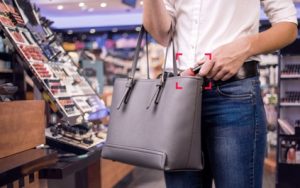
The ever increasing number of shoplifting incidents is forcing retailers to turn to facial biometrics as a security measure. This has yielded impressive results: store owners confirm that such security systems identify thieves by their face and cite a reduction in theft-related losses between 50 and 90%. Modern facial recognition systems employ advanced algorithms that both ensure data privacy and adhere to international GDPR regulations.
Retail Theft and Robberies Increase Damage
Retail store managers have noted a recent rise in thefts and robberies. As reported by Charged, a British retail news outlet, this disturbing trend emerged in 2018-2019, and has since evolved into a pressing issue. Interestingly, the rise in shoplifting incidents coincides with a broader surge in crime rates, as independent research portal Numbeo assigns a ”high” rating to this metric in many Latin American cities.
The increase in retail attacks, as well as a growing level of aggression from organised groups, is prompting widespread concern. The 2021 “Retail Security Survey: The State of National Retail Security and Organized Retail Crime” report by the National Retail Federation provides some alarming statistics. According to the report, 64% of respondents observed a surge in losses from organised criminal groups since 2016, while 53% reported an escalation/increase in theft. What is more, 82% of respondents mentioned intensification in the ferocity of attacks and the involvement of weapons.
The National Retail Federation approximates the average loss per theft incident in a store at $462, with organised robberies amounting to nearly $7,500. Furthermore, data from the British Retail Consortium, as reported by the Daily Mail, reveals an alarming increase in store theft incidents, soaring from 3 million cases in 2016-2017 to 8 million in 2022.
The often delayed response of the police to shoplifting incidents leaves retail businesses vulnerable to theft. Store employees, wary of potentially armed perpetrators, avoid personally confronting suspects, while law enforcement personnel respond to incidents only after the criminals have already made their escape. Additionally, theft cases below a certain monetary value are often deemed low-priority and go uninvestigated.
Fortune Business Insights predicts the global facial recognition technology market to reach an impressive $13 billion by 2027, with a compound annual growth rate (CAGR) of 14.8%. The 3D recognition sector exhibits even swifter growth, with Market Research Future reporting a CAGR of 21.6%.
However, it is Latin America that is considered the most favourable region for biometric technology development, with its biometrics market surpassing the global growth rate by far. Multiple research firms, including Inkwood Research, anticipate that the Latin American biometrics market will hit a volume of $8 million by 2027-2028, with a CAGR of 17-22%. Analysts identify Brazil, Mexico, and Argentina as key influencers in the regional development of biometric technologies. This trend is attributable to both governmental investments in initiatives like safe cities or digital identification, and private sector endeavours to mitigate the escalating crime rates.
Retailers are finding effective protection against growing losses through a combination of organisational protocols, staff training, and the adoption of ready-to-use security solutions, such as anti-theft systems, in- store surveillance, and biometric technologies.
Facial recognition systems have proven to be highly effective in preventing theft and robberies. For example, according to the Daily Mail, a facial biometrics system installed in a major retail store chain prevents thousands of crimes each month. Additionally, Charged disclosed that a local convenience store saw a staggering 90% reduction in losses following the installation of an AI-based system.
Facial biometric systems assist security services in monitoring the store and promptly identifying any infractions. Here’s how it works:
1. Cameras installed in the store capture video footage, which the system then uses to extract facial images and create biometric profiles stored in a database.
2. The system continuously cross-references real-time video data against the biometric profiles already catalogued in the database.
3. In case a customer previously involved in theft, vandalism, or similar incidents features on the “stop list”, the system notifies the security service, prompting closer monitoring of the said individual.
By integrating facial biometrics with video analytics, the system can quickly detect suspicious activities and alert security personnel. The incorporation of facial biometrics helps to: significantly reduce losses from theft, robbery, and vandalism, improve the efficiency of security services, lessen the strain of manually sifting through footage from multiple cameras, minimise the potential for human error in in-store security, enhance interaction with customers by incorporating biometrics into marketing systems.
Police departments also benefit from increased crime-solving rates, while retail industry professional associations can curb recurrent thefts by sharing “stop-lists” and biometric data on criminal gangs and individual offenders.
Achieving a 3-Year Payback Period with Facial Biometrics: A Case Study from a Brazilian Shopping Center
Jockey Plaza, a shopping centre in Curitiba, Brazil, implemented a comprehensive security system featuring video analytics and facial biometrics. This modern facility, spanning 200,000 square metres, accommodates 400 stores and 28 food establishments.
The security system project was a collaboration between Francaza, a Brazilian integrator, and RecFaces, a facial biometrics solution developer. To enhance the security of the shopping centre, automate security operations, and expedite crime investigations, they chose to employ RecFaces’ Id-Guard facial identification software. Id-Guard seamlessly integrates with the video surveillance and video analytics systems, offering biometric identification, real-time and retrospective face search within video streams, and stoplisting capabilities.
“The moment a person on the stop-list enters the camera’s field of view, the operator is immediately notified. Based on our experience, implementation of Id-Guard saves security specialists time as they no longer have to spend hours sifting through video footage when investigating incidents”, says Cristiano J.S. Maffessoni, Francaza’s CIO.
According to Cristiano J S Maffessoni, the payback period for the Jockey Plaza shopping centre project is less than 3 years thanks to a 50% cut in shoplifting instances, swift resolution of crimes, and increased efficiency of security services. The return on investment for biometric systems typically spans 1 to 3 years, depending on the crime rate in the vicinity of the shopping centre. To calculate effectiveness, it is necessary to evaluate average loss per incident, the average number of similar incidents annually, and the incident reduction rate, generally fluctuating between 30% and 70%, based on the security service’s efficacy.
Maria Kazhuro, RecFaces’ BDM in Latin America, shares, “RecFaces has developed two lines of ready-to-use biometric solutions specifically designed for the security and retail sectors. We’ve seen an immense demand for our ready-made solutions in Latin America, thanks to their quick and easy deployment on any equipment. Our solutions allow customers to identify offenders, instantly respond to incidents, conduct marketing research, and foster customer loyalty.”
RecFaces’ Id-Guard, a biometric ready-to-use solution, stores only biometric templates – feature vectors that cannot be reconstructed into facial images – in its database. This data storage method adheres to international GDPR data protection regulations and is supplemented by AES-256 standard encryption mechanisms for critical data.











